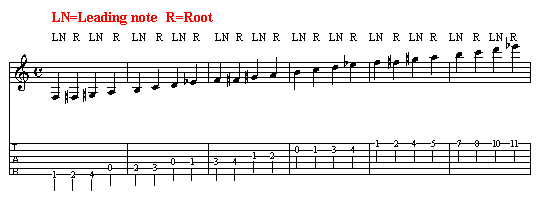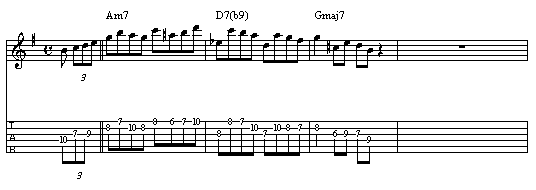Part One: Melody
Focuses on single note soloing. Learn how to effortlessly solo through complex chord changes.
Free Jazz Guitar Lessons with Chris Standring
Let's look at the diminished scale using the linear concept so we can incorporate the arpeggio and scale into our melodic lines.
The make up of the diminished chord allows us to use the same chord shape for 4 different chord names. A diminished chord is made up of: Root, b3, b5 and 6th (otherwise known as diminished 7th). That means that each interval is exactly a minor 3rd away from each other. If we took the root as A, the chord tones would be: A,C,Eb,Gb. If C was the root note our chord tones would be: C,Eb,Gb,A. If Eb was the root, our chord tones would be: Eb, Gb, A, C. Finally if Gb was the root note our chord tones would be: Gb, A, C, Eb. The minor 3rd intervals keep going up until the end of the 4 note sequence and start over again.
This means that the diminished scale is quite difficult to really hear as there seems to be no final note to feel comfortable about when you get to it. There are 4 final notes! However, this also means that there are only 3 scales to learn as opposed to 12.
The diminished scale can be thought of as quite simply, the notes of the diminished chord with a leading note placed before each chord tone. The scale then looks like this:


Every dominanth 7th b9 chord has a diminished chord within it. This allows us to utilize the diminished scale when playing over chord 5. It also gives us nice stepwise resolutions when we finally get to the 1 chord. Look at the following 2, 5, 1 progressions and study the diminished lines when they appear over chord 5. Have fun!










Free online jazz guitar lessons for beginners, intermediates and advanced.
Online jazz guitar instruction from recording artist Chris Standring
Join The Inside Track membership and get access to all Chris Standring's guitar instructional programs, all in one place.
It has been many years since the first edition of Play What You Hear (originally released in 2000). Now volume two is here with new ideas and concepts, complete with audio, video, traditional notation and TAB throughout. High resolution pdf available for printing the entire program. For intermediate and advanced players.
Focuses on single note soloing. Learn how to effortlessly solo through complex chord changes.
Focuses on chord melody. Learn new harmonic devices and understand chords in a whole new way.
Study Chris Standring's six recorded solos, transcribed with audio and high def video.
Copyright © PlayJazzGuitar.com - All Rights Reserved.